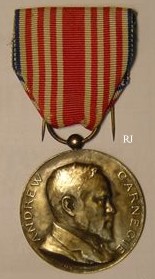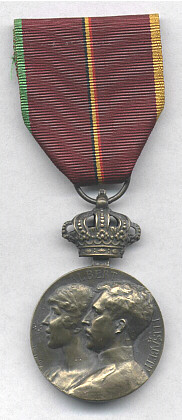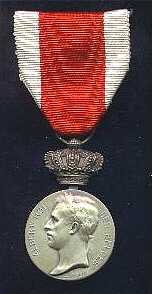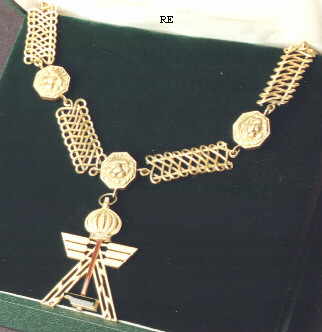

Other Belgian medals instituted during the Reign of King Albert I
Originally, at its inception by the Belgian government in 1911 after Mr. Andrew Carnegie had provided funds, the medal was not wearable. At the occasion of its 50th birthday, in 1961 a new medal, smaller in size but with the same obverse and reverse was struck for wear by the recipient. Three classes of the medal exist, in gold, silver and bronze, to denote the importance of the conditions in which it was earned. The medal is awarded to those that, voluntarily and in immediate and serious danger of losing their lives, save the life of a fellow human. The gold medal is only and rarely awarded in case of an exceptional act of heroism, in practice these awards are nearly always posthumous. The silver medal is awarded for a remarkable act of heroism in which the recipient was seriously wounded. The bronze medal serves to reward life saving acts of heroism in which risk of one's life was definitely present. The medal depicts the head of Andrew Carnegie on its obverse, with his name around the rim. The reverse is a representation of a man protecting an adolescent and pushing a demon away with his foot, around the rim are the words "CARNEGIE HERO FUND". The ribbon is red with blue and white stripes in a pattern representing the colours of the USA. |
 |
 |
Awarded to all military and former military personnel that served in the mobilized Belgian Army between 15 July 1870 and 5 March 1871. This medal was instituted by King Albert I, on 20 September 1911, to commemorate the mobilisation of the Belgian Army during the Franco-Prussian War. |

As a result of an invitation by the Brazilian President, King Albert I and Queen Elisabeth boarded the Brazilian dreadnought "Sao Paulo", the first large vessel to put into a Belgian port after the First World War, on 1 September 1920. After his return to Belgium, King Albert I instituted a bronze commemorative medal on 25 November 1920. Recipients were officers and crew of the "Sao Paulo" as well as Belgian and Brazilian civilians on board the battleship during the voyage. It should be noted that the crown suspension on this medal is solid and that restrikes are known to exist with an open crown as in the picture below.. |
 |
 |
This silver medal was instituted on 8 August 1921 and awarded as a commemorative to some 450 persons, including only 28 members of the Belgian Olympic Team that had distinguished themselves during the games. Most awards went to high ranking personalities. These VIIth Olympic Games were the first ones held after the First World War and took place in Antwerp in 1920. It should be noted that the crown suspension on this medal is solid and that restrikes are known to exist with an open crown. |
 |
 |
This enameled cross was created on 20 October 1921 to commemorate the 75th anniversary of the first telegraph line exploitation in Belgium, on 9 September 1846. It was awarded to employees and workmen of the Belgian Telephone and Telegraph Services who had completed, on 9 September 1921, 25 years of good and loyal service. |
The proper name for this medal is "The Commemorative Decoration for the 75th Anniversary of the issue of the first postal stamp in Belgium and the 50th Anniversary of Belgium's participation in the universal postal union". This bronze medal was instituted on 2 May 1924 and awarded to employees and workmen of the Belgian Postal Services who had completed, on 1 July 1924, 25 years of good and loyal service. |

This attractive bronze gilt medal, also often referred to as "Colonial Veterans Medal", was instituted on 21 January 1929 to "recognize the merit and devotion to duty of the agents of the International Association of Congo or of the Independent State of Congo, members of societies and missionaries and trades people who, during the period between 1879 and 18 October 1908, had with valorous belief and under the impulse of the Founder of the Colony, its Sovereign Leopold II, contributed to opening up Central Africa to civilisation". Requirements for the award were an uninterrupted and complete period of minimum two years in Congo, working with honour, zeal and dedication. |
In order to encourage and develop worker's enthusiasm and knowledge and to stimulate their sense of initiative and progress, distinctive awards were instituted on 14 March 1929. Over the years the titles of these awards and their respective badges and emblems were changed so that today the following grades are in existence :
The criteria and the changes in them over the years would take many pages of rather boring text. Suffice it to say that there is only one Doyen of Work per category of industry (previous Doyens are, on stepping aside voluntarily, entitled to the Honorary Doyen title and badge). Laureates of Work can receive, according to their relevant competence, an award in bronze, silvered bronze or gilt bronze. This distinction is awarded at a moment where the recipient is acknowledged to be an expert in his or her field. The Star of the Cadet of Work serves to distinguish young workers who already distinguished themselves by their excellence in their profession. The Honorary Laureate of Work title is conferred on those rendered eminent services to the Royal Institute of the Worker's Elite whereas the Honorary Cadet title serves to distinguish those people, not directly related to a branch of industry, that - through their moral and effective support - have inspired young people to integrate in society. |
 |
 |
| Doyen of Work - 1935 type | Doyen of Work - 1948 to present type |
Laureate of Work badges, type 1948 and type 1963 to present |
This silvered bronze medal was awarded to all who, before 1 January 1931, had served the country loyally for minimum 20 years and through that fact were eligible for either the Civic Decoration for Long Service in the Administration, the Military Cross or the Military Decoration. King Albert I instituted this medal on 20 July 1930. |
 |
 |
Copyright Hendrik Meersschaert 2024 ©